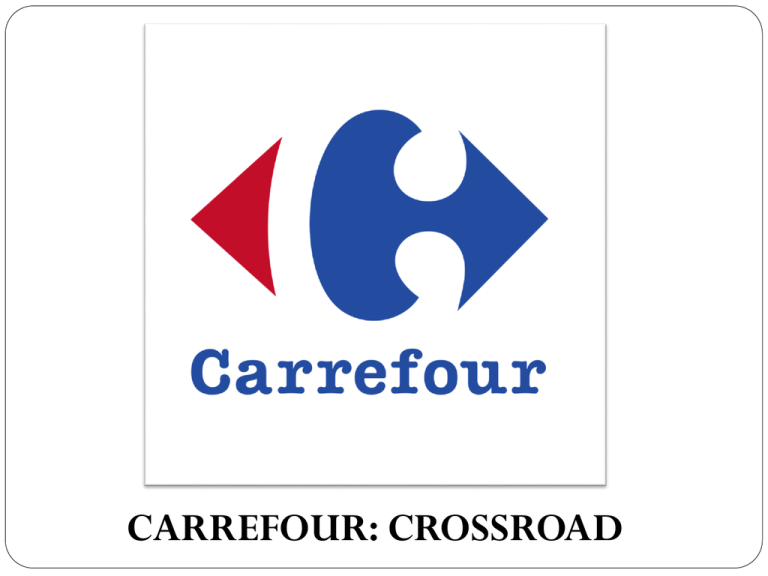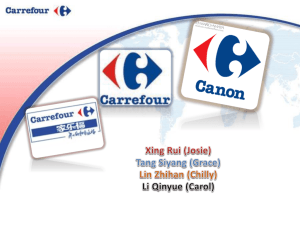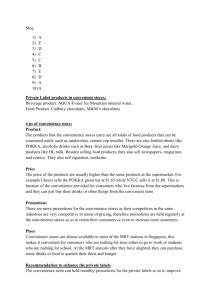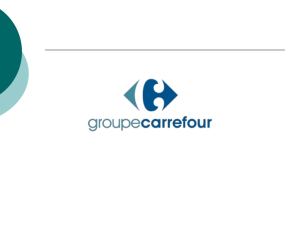carrefour: crossroad
advertisement

CARREFOUR: CROSSROAD Content to be covered: Company overview and main business in the world Business Model Analysis Carrefour in China Understanding the Chinese market and consumers Situation and competitors’ analysis (local & int’l) Major Problems Next Step Out Company Overview • Established in 1959 • France/Europe/Latin America/Asia • Current operating profit: 766 million euros Company Overview Cash & carry stores Convenience stores Hypermarkets French Multichannel Retailer Supermarkets E-Commerce Hard Discount stores Main business in the world Hypermarkets Offer wide range of food and non-food items Low prices Targeted promotions 1,300 globally Main business in the world Cash & Carry stores Carry a range of food and non-food items at wholesale prices Support the work of caterers and convenience food stores Promocash (France), Dock Markets (Italy), Carrefour Wholesale Cash & Carry (India) 160 stores Main Business in the world Hard Discount Stores Operate under the names of stores that Carrefour acquired Low prices all year round “Dia” in Spain, Greece and Argentina, “Minipreço” in Portugal 365 stores Product (Service) Promotion Business Model Analysis Price Place Business Model Analysis Product (Service) - One-stop shopping area for consumers - Wide range of food and non-food items - Focuses on high volume Place - Carrefour has the business strategy of opening their outlets at crossroads as it believe that it will attract consumers Business Model Analysis Price - Low prices to consumers - Charge suppliers high prices and requested for more rebates - Low profit margins from the sales of goods, higher profit margins received from the suppliers Promotion - Emphasizes on price competitiveness and quality of goods Carrefour in China Entered the Chinese market in 1995 with the hypermarket concept Consumers’ first choice when Carrefour first entered Aimed to provide a one-stop pleasant shopping experience for the consumers Focuses on high volume and low prices 218 outlets as of the end of 2012 How Carrefour understand the Chinese market and Chinese consumers? 1) Amended their business practices: Provided more management positions for the locals Letting the local managers take charge of orders, purchasing, pricing, employee recruitment, promotional campaigns and arrangement of store displays How Carrefour understand the Chinese market and Chinese consumers? 2) Analyzing consumer habits Outlets have more parking spaces for scooters than cars as compared to other countries Sell live fish to consumers from bigger coastal cities who prefer their fish alive Frozen fish to Chinese from West and Middle China who prefer their fish to be fresh Brought in bigger shelves to place all different brands of a similar product in the same area Situation and Competitors Analysis Situation and Competitors Analysis Supplier Power • Reputable brand • Charging fees to suppliers to maintain healthy cash flow Eating into suppliers’ profits • Only big enterprises (e.g. Master Kong, MonMilk) can afford to stop supplying to Carrefour. Small and medium enterprises have no choice. • Operation model of charging high slotting fees is successful in China other supermarkets are following it Leaves suppliers with little bargaining power Situation and Competitors Analysis Buyer Power • Many options in the market-Walmart, RT Mart, Tesco,Yihaodian • Convenience Carrefour prides itself on being the “next door” supermarket based on its crossroad concept. But it still cannot beat the convenience that online retailers like Yihaodian brings: Having items sent right to one’s doorstep • Price has a strong effect on consumers’ decisions Supermarkets compete by offering low prices Bargaining power of buyer is HIGH! Situation and Competitors Analysis Threat of New Entrants • High barriers to entry • Large supermarket chains require abundant funds as quantity of stores ensure the success in the market • Existing large supermarkets all hold significant amount of market share Situation and Competitors Analysis Threat of Substitutes • Substitute products can be found in other supermarkets or convenience stores • Being a hypermarket, Carrefour stands out from its convenience stores competitors by having cheaper prices, higher product variety and many locations • Substitute products (maybe even at a cheaper price) from online retailers such as Yihaodian, Womai etc. Situation and Competitors Analysis Intensity of Rivalry • Many competitors, from big supermarkets to small convenience stores • Market share lessened due to great number of branded businesses flooding the country, including Walmart and French-based Auchan • Carrefour has the highest rate of setting new stores and the total number of stores have surpassed its competitors Challenges Faced Corruption Quality and safety of goods Very diverse cultures in different parts of China Have to cater to different consumer groups Inefficient supply chain management What’s the next big step for Carrefour? Short-Term Medium-Term Long-Term Short-Term Strategy QR Code shopping: Customers get to shop in Carrefour’s retail store by scanning the QR Code of each item QR scanning will provide: (i) Information on products such as manufacturing date, expiry date, place of manufacture and production process increase food safety and product knowledge (leads to higher credibility) (ii) Consumers can purchase directly and goods will be delivered to the counter where they can proceed to pay Shopping made convenient No more having to carry heavy baskets of stuff with huge trolleys getting in the way! Medium-Term Strategy E-commerce shop: Online shopping baskets are more than offline shopping baskets (Average transaction size for F&B- $80 online, $30 offline. Health and beauty purchase- $30 online, $10 offline) Have to keep up with China’s ecommerce trend (e.g. Walmart investing in Yihaodian) Long-Term Strategy Catalogue Shopping: Customers receive catalogues whereby they can scan QR codes of the products they want to buy and have it delivered to their doorstep Feasible in the long term after an efficient shipping service is set up after the appearance of an online platform References Why Carrefour is struggling to keep up with Chinese shoppers. (2013, June 24). Retrieved September 24, 2013, from Quartz: http://qz.com/97251/why-carrefour-is-strugglingto-keep-up-with-chinese-shoppers/ Bentonville, A. (2012, October 26). Walmart Global eCommerce Completes Increased Investment InYihaodian. Retrieved September 24, 2013, from Walmart: http://news.walmart.com/news-archive/2012/10/26/walmart-globalecommerce- completes-increased-investment-in-yihaodian Hui, L., & Cheng. (2011, October 19). Slotting Fees Hit Suppliers. Retrieved September 24, 2013, from 商报 网: http://cib.shangbao.net.cn/c/59664.html Lin, M.-Q., & Liang, W.-K. (n.d.). A Comparative Study of Asia Strategy:Wal-Mart versus Carrefour. Retrieved September 24, 2013, from http://citeseerx.ist.psu.edu/viewdoc/download?doi=10.1.1.202.50&rep=rep1&type=pd f liu, w. (n.d.). 家乐福商业模式. Retrieved September 24, 2013, from 360Doc: http://www.360doc.com/content/11/0415/22/1284834_109947141.shtml Perkowski, J. (2012, October 24). International Retailers Struggle In China. Retrieved September 24, 2013, from Forbes: http://www.forbes.com/sites/jackperkowski/2012/10/24/international-retailers- struggle-in-china/ Staertzel, L. (n.d.). Carrefour in China. Retrieved September 24, 2013, from http://bear.warrington.ufl.edu/oh/IRET/Student%20Experience/Carrefour%20Essay% 20Edited.pdf The Nielson Company. (2010). Global Trends in Online Shopping. Vidalon, D. (2013, August 29). Carrefour profit rises as French recovery plan delivers. Retrieved September 24, 2013, from Reuters: http://uk.reuters.com/article/2013/08/29/uk-carrefour-earnings-idUKBRE97S09S20130829








